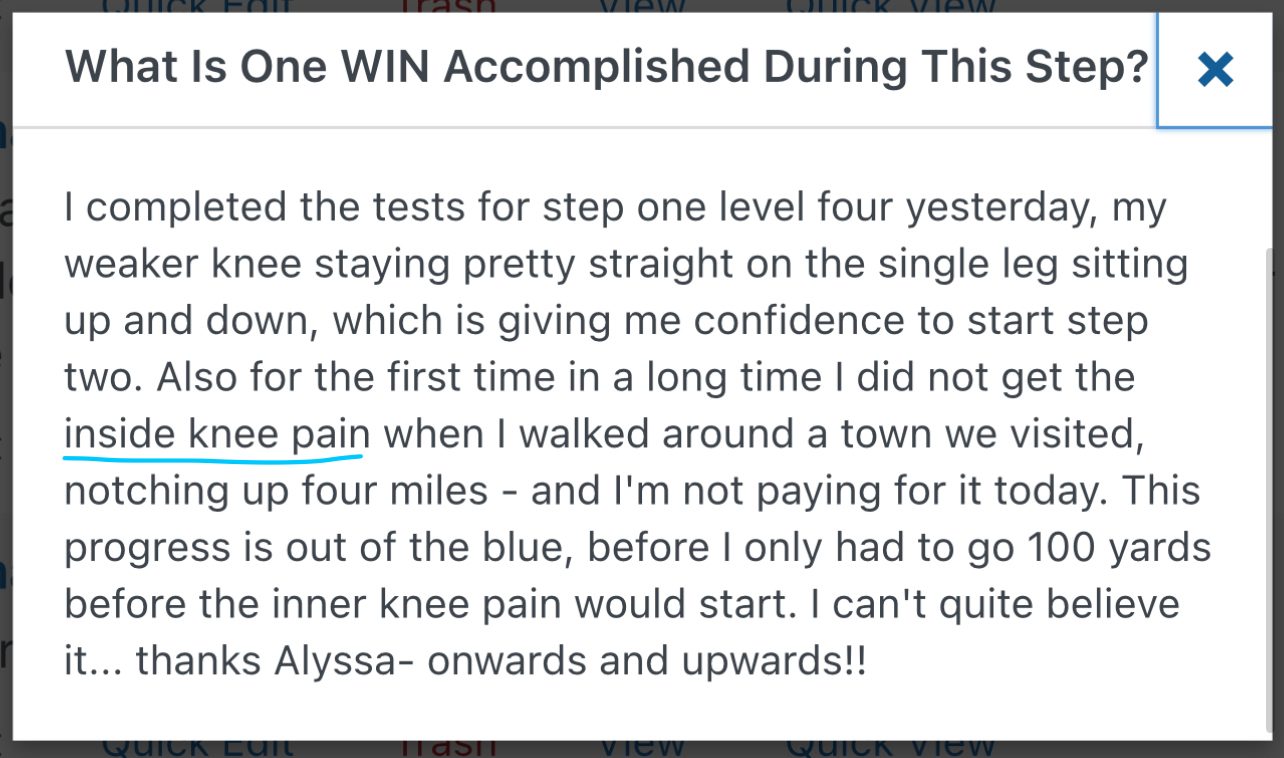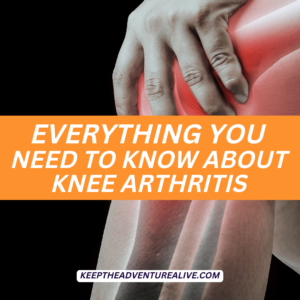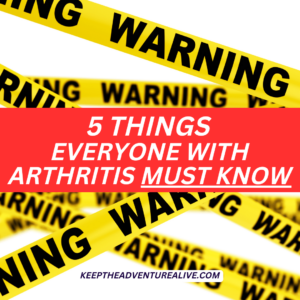Inside knee pain, also known as medial knee pain, can lead to difficulty doing common activities like walking and climbing stairs. With so many different things that could cause this pain, it is understandable that many become frustrated. This can often lead to being unmotivated, decreasing activities, and not being able to adventure as life requires. I am here to tell you it doesn’t have to be that way! Here you will find out what may be the root of your pain and find out how you can achieve pain relief!
Knee pain is incredibly common and could mean many different things. Knee pain isn’t always severe and I want you to know that there are options when it comes to finding relief.
“Knee pain affects approximately 25% of adults. The prevalence of knee pain has increased almost 65% over the past 20 years, accounting for nearly 4 million primary care visits annually” (Bunt et al 2018).
One of the more common places for knee pain is actually on the inside of your knee, also known as medial knee pain. Some of the primary causes include osteoarthritis, acute injury to ligaments, and/or meniscus involvement.
It is possible to find relief from inside knee pain. With the right movements to help build muscle support around the joints and improving the way you move, many doors can open for you.
Take this example from a member of Adventurers for Life, my signature membership program.

In this article we will go into depth on the causes of medial knee pain and what you can do to find relief and avoid serious procedures.
Common causes of inside knee pain
If you are experiencing pain on the inside of your knee, it may not be serious. It is important to know what typically causes it in order to begin to match your symptoms to a potential reason.
Acute injuries
Did you recently experience a fall or an incident when you injured your knee? For example a recent sports injury or stepping wrong out of the car that resulted in a twisting feeling?
If you have experienced a recent injury and now are experiencing medial knee pain- here are a few potential causes.
Acute injuries tend to happen suddenly and cause pain, swelling, bruising, weakness, etc.
- Medial Collateral Ligament (MCL) sprains/tears/irritation: this ligament runs along the inside of the knee and is commonly injured from a force coming from outside the knee, forcing your knee inwards. If you have feelings of instability, locking/catching in the knee, swelling, pain with walking or bending your knee- this could be a potential cause.
- Medial Meniscus Tear: Your meniscus is a structure sandwiched in between the bones that make up your knee. It helps to absorb shock when walking, running, etc so all of the stress isn’t going right to the joint. The medial meniscus gets injured most often from quick, twisting motions such as pivoting in tennis, basketball, etc. If you have popping, clicking, difficulty putting all of your weight on that leg, and reduced pain when sitting- this could be a potential cause
What do I do after an acute injury?
If you have recently had an injury or suspect you may have one of the conditions described above, the first course of action is to see your primary care physician or a physician that you regularly see. You will likely be sent to imaging to rule out any other potential complications such as a break in the bone(s).
Once fractures and other more serious complications are ruled out, the best course of action is to avoid overstressing the injured area. This does not always mean complete rest…
Keep reading for some tips on how to proceed.
Overuse injuries
Overuse injuries typically happen after sudden increases in activity, or after frequent, repetitive motions without adequate strength and flexibility. Essentially, this happens when you ask your joints to do a ton of activity that they weren’t prepared for.
A common occurence I see as a physical therapist is dramatically increasing walking distance. For example, if you regularly walk 2-3 blocks each day then suddenly walking 3 miles with a friend can lead to an overuse injury.
These injuries don’t always have an exact mechanism of injury and it may be difficult to recall exactly when the pain started. They tend to worsen over a time period of months to years.
Here are some common overuse injuries that can contribute to medial knee pain:
- Bursitis: A bursa is a fluid-filled pad that reduces friction between bones and muscles and other structures. A bursa can become irritated because of too much friction, repetitive motion, and/or muscle imbalances leading to movement compensations. The inside knee may be tender to touch and/or swollen.
- Plica Syndrome: plica are folds in the lining that surrounds the knee joint. These folds may become irritated and inflamed with overuse. They can become thickened, tight, and lose elasticity. This can lead to inside knee pain, tenderness to touch, and/or popping and clicking with certain movements like a squat.
- MCL Sprain/Tear: Mentioned in the acute injuries above, MCL injuries can also occur from repetitive movements that place too much stress on the ligament. Symptoms include inside knee pain, swelling, stiffness, and/or tenderness.
What do I do after an overuse injury?
First, it’s important to look back and think about if you have recently increased any sort of activity. Ask yourself these questions:
- Did I recently do an activity or movement that was new or that I wasn’t used to? (for example, going hiking for the first time in a while, climbing stairs, trying a new sport like pickleball, etc)
- Did I recently do significantly more activity than usual? (for example, walking or running a longer distance, riding a bike 2-3x the distance you usually do, etc)
Other causes
One of the most common causes of inside knee pain outside of the above categories is:
- Osteoarthritis: Your knee is made up of three compartments (inside of the knee, outside of the knee and the kneecap), each which can be affected by arthritis. The inside of the knee is one of the most common compartments to be affected. Common symptoms can include inside knee pain, stiffness especially in the morning, loss of range of motion in the knee, and/or joint swelling. Take a look at other common symptoms here.
Osteoarthritis usually comes on gradually although sometimes it may feel like it came on suddenly. There is more to osteoarthritis than just simply overuse (i.e running too much when you were younger), so I believe it deserves it’s own category.
This is the condition I work most closely with. Find out more details about knee osteoarthritis here.
Some other, less common, diagnoses that may be the cause of your inner knee pain are: fractures, nerve entrapment, impingement syndromes, tendinopathies, and referred pain from the back or sciatica.
What can I do about my inside knee pain?
When dealing with inside knee pain, certain strategies can help to reduce pain and also reduce the risk of re-injury. There are some occasions where complete rest is indicated but it may not be as necessary as you think…
Most of the time, some degree of movement can help to facilitate healing.
Here are three things you can do to reduce inside knee pain:
1. Movement
Research has shown time and time again that movement plays a key role in reducing and preventing injury as well as keeping joints such as your knee healthy.
“Evidence has shown that active management (e.g., stretching, strengthening, exercise programs) is more effective in decreasing knee pain and improving function than passive modalities (e.g., therapeutic ultrasonography, electrical stimulation, taping, cryotherapy, heat)” Jones et. al, 2015
Strengthening both the fronts and the backs of your legs are vital to supporting the knee joint and healing inside knee pain. There are many ways to modify certain movements, especially if you are currently in pain.
The muscles that surround your knee are incredibly important. Oftentimes, even just a few days of complete rest can result in muscle weakness. This is why it’s so important to keep moving.
Depending on your injury and/or pain levels- the movement your body is ready for may look different. When healing, it’s important to avoid stressing the area of injury too much.
Gentle movement is very important as it helps to promote blood flow and bring in helpful cells to the joint. Movements that are too strenuous could increase irritation and sensitivity.
Here is an example of a gentle, seated movement routine that can get the whole body moving that can be helpful in reducing knee pain:
2. Prioritizing sleep
Believe it or not, sleep plays a vital role when it comes to healing your body. Whether you are dealing with chronic pain (pain lasting more than 3 months) or an injury that just happened, adequate sleep is necessary.
Poor quality of sleep can actually increase the sensitivity of pain. If you don’t get enough sleep, situations that normally wouldn’t irritate you- might elicit a negative reaction. Likewise, you may find yourself getting much earlier or at a higher magnitude, compared to a day when you have gotten good sleep.
Your body, more specifically, your knee can respond in this same way. Certain activities that normally wouldn’t hurt, may hurt on days where sleep is lacking. You may also experience higher pain levels than usual.
But if you’re in pain, sleep can be an issue. Sometimes inside knee pain can wake you up at night.
One trick that can be very helpful is sleeping with a pillow between your knees, as long as your inner knee isn’t painful to touch. You may also want to try heating or icing before bed.
Here is another article about other tips you can use to improve your sleep.
3. External supports
When you’re in pain, especially inside knee pain, your knee is searching for support. One simple thing that can actually help with pain sensation is compression.
A neoprene knee sleeve can be very helpful to reduce pain sensations as the feeling of pain and compression are felt on similar receptors in your body. So if compression is present, you may not experience as much pain.
I have a list of my favorite neoprene knee sleeves here. They are inexpensive and can help to minimize swelling while helping to reduce irritation.
You may also be given a brace with hard parts in it, depending on your injury. If prescribed by your physician, it can be helpful to offload some bodyweight from the inside of the knee.
If not prescribed one of these braces, I would highly recommend trying a neoprene knee sleeve first. The braces with the hard pieces in them can be very large, cumbersome, hard to move in, and can facilitate movement compensations as they change the way you move.
If you don’t have a knee sleeve, you can also use an ACE wrap to wrap your knee. It is more difficult to regulate the compression so make sure you are not putting it on too tight. If it’s too loose, it may not be providing enough compression to bring the benefits.
Conclusion
If you are experiencing inside knee pain, there are many different causes. Whether it’s a new pain from a recent injury or it’s a pain you have been dealing with for a while- there is something you can do about it!
Please note that conservative measures (movement, sleep, braces) may not work for everyone. If you continue to experience significant levels of pain- surgery may be an option.
There are options for meniscus surgery (outcomes may not always be the best, read this article for more), joint replacement for knee osteoarthritis (read more on that here), and other reconstruction surgeries primarily for the other ligaments in the knee.
References
Bunt, Christopher W et al. “Knee Pain in Adults and Adolescents: The Initial Evaluation.” American family physician vol. 98,9 (2018): 576-585.
Written in collaboration with Kayci Smith, student physical therapist
Alyssa Kuhn
Disclaimer: This post is for general informational purposes only. It should not be used to self-diagnose and it is not a substitute for a medical exam, cure, treatment, diagnosis, and prescription or recommendation. It does not create a doctor-patient relationship between Dr. Kuhn and you. You should not make any change in your health regimen or diet before first consulting a physician and obtaining a medical exam, diagnosis, and recommendation. Move Well Age Well, LLC and Dr. Alyssa Kuhn, PT, DPT are not liable or responsible for any advice, course of treatment, diagnosis or any conclusions drawn, services or product you obtain through this post, video or site. Complete all exercises at your own risk.

If you are looking to regain your active life but are unsure where to start, join the revolutionary membership, Adventurers for Life. This is a step-by-step path that not only will help you find pain relief but will help you unlock adventure. You’ll get workouts, tests to pass to make sure you are on the right track, community events and MORE.




